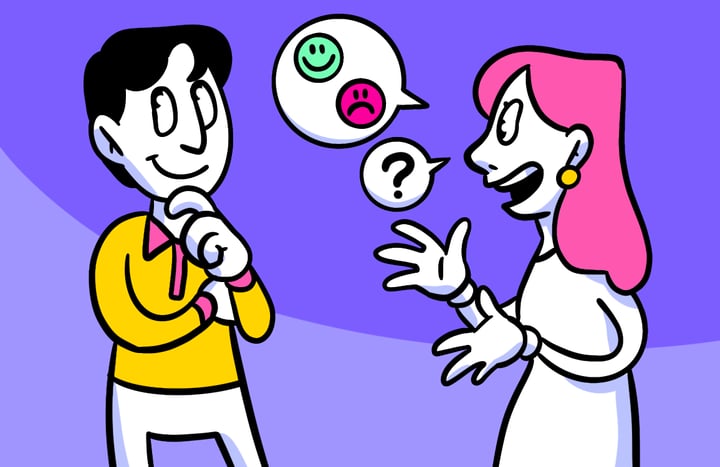A Comprehensive Prototype Testing Example: Unveiling the Key Steps and Best Practices
Prototype testing is an essential part of the product development process. It allows designers and developers to gather valuable insights and feedback before investing significant resources into building the final product. By testing a prototype with users, teams can identify usability issues, make necessary improvements, and ensure that the final product meets users’ needs and expectations.
🔩 The Nuts and Bolts:
- Prototype Testing Drives User-Centric Design: Early user engagement through prototype testing ensures products meet real needs. This approach uncovers usability issues and design flaws, guiding teams towards user-centric solutions.
- Clear Objectives Define Success: Setting precise goals for prototype testing sharpens focus and enhances outcome relevance. Defined objectives guide the formulation of specific user tasks, leading to more actionable feedback.
- Fidelity Influences Feedback Quality: The level of detail in a prototype affects the feedback’s applicability. Whether low or high fidelity, the prototype should match testing objectives to yield meaningful and actionable insights.
- Diverse Participant Recruitment Enhances Insights: Selecting target audience participants uncovers varied perspectives. This diversity in feedback ensures that the product appeals to a broad user base.
- The Testing Environment Matters: Choosing the right setting for prototype testing, whether in a lab or remotely, can influence the feedback quality. The environment should facilitate natural user interactions for authentic insights.
- Feedback Analysis Leads to Iteration: Categorizing and prioritizing user feedback informs the subsequent design iterations. This process of continuous refinement is essential for developing a product that genuinely meets user expectations.
- Best Practices Amplify Results: Effective communication, iterative testing, and integrating user feedback are pillars of successful prototype testing. These best practices ensure a productive testing phase and a more user-aligned final product.
Understanding Prototype Testing
Before discussing the key steps and best practices of prototype testing, it’s important to understand its significance. Prototype testing involves creating a scaled-down version of the product or a specific feature and gathering feedback from users. This early interaction helps identify design flaws and usability issues, enabling teams to iterate and refine their ideas before reaching the final product.
Prototype testing is a crucial step in the product development lifecycle. It allows designers and developers to validate their assumptions and make informed decisions based on user feedback. By involving users in the design phase, teams can ensure that the final product meets their needs and expectations.
The Importance of Prototype Testing
The main advantage of prototype testing is gathering user feedback early in development. Developers can better understand the target audience’s needs and preferences by involving users from the start. This user-centered approach ensures that the final product aligns with users’ expectations, increasing customer satisfaction and reducing the chances of costly redesigns later on.
Prototype testing also allows teams to identify and rectify usability issues before product launches. By observing users interacting with the prototype, designers can gain valuable insights into how people navigate through the interface, identify pain points, and optimize the user experience. This iterative process helps in creating a seamless and intuitive user interface.
Critical Concepts in Prototype Testing
Before initiating prototype testing, it’s crucial to familiarize yourself with some key concepts. Firstly, it’s essential to define the objectives and goals of the test. What specific aspects of the design or functionality are you aiming to test? Clear objectives will help in designing precise questions and tasks for participants.
Secondly, prototype fidelity plays a vital role in the testing process. Fidelity refers to the level of detail and realism in the prototype. Low-fidelity prototypes, such as paper sketches, focus on the core functionality, while high-fidelity prototypes closely resemble the final product in design and interactivity. The level of fidelity should align with the test objectives and the stage of the development process.
Another essential concept in prototype testing is the selection of participants. Recruiting users who represent the target audience is crucial to ensure that the feedback received is relevant and actionable. By involving a diverse group of participants, teams can gather a wide range of perspectives and uncover potential issues that may have been overlooked.
Furthermore, the testing environment can also impact the results of prototype testing. Conducting the test in a controlled environment, such as a usability lab, can provide more accurate insights. However, remote testing can be effective, especially with a geographically dispersed user base. The choice of the testing environment should be based on the objectives of the test and the resources available.
Lastly, it is important to analyze and interpret the feedback collected during prototype testing. By categorizing and prioritizing the feedback, teams can identify common patterns and prioritize the necessary design changes. This analysis phase is crucial in ensuring that the final product addresses the identified issues and meets the users’ needs.
Make your design decisions count.
Subscribe to Design Under Pressure. Get insights, UX metrics, and tools for bold, informed design.
We respect your inbox. Just insights. No fluff. Privacy Policy.
The Process of Prototype Testing
Now that we understand the importance of prototype testing let’s explore the critical steps involved.
Prototype testing is a crucial stage in the product development lifecycle. It allows designers and developers to gather valuable user feedback, ensuring that the final product meets their needs and expectations. By involving users early on, prototype testing helps identify usability issues, uncover design flaws, and validate assumptions.
Initial Planning and Preparation
The first step in prototype testing is to define the research questions and objectives. What insights are you seeking to gain? Are you testing a specific feature or evaluating the overall user experience? Once you have a clear direction, it’s time to recruit participants who match your target audience and schedule test sessions.
Recruiting the right participants is essential for obtaining meaningful feedback. Consider factors such as age, gender, occupation, and familiarity with the product domain. By selecting participants who closely resemble your target users, you can ensure that the feedback you receive is relevant and representative.
In parallel, you should prepare the prototype for testing. Ensure it is interactive, functional, and realistic enough to elicit valuable feedback. Assign tasks or scenarios that mimic real-world use cases so that users can provide feedback relevant to their needs. This will help you identify usability issues and understand how users interact with the prototype in a natural setting.
Execution of Prototype Testing
After the planning and preparation are done, it’s time to conduct the actual prototype testing sessions. Start by introducing the purpose and context of the test to participants, ensuring they understand their role and expectations. Then, create a comfortable and relaxed environment where participants feel encouraged to share their thoughts and opinions.
During the sessions, observe participants’ behavior closely, noting any emerging usability issues or patterns. Pay attention to their facial expressions, body language, and verbal cues. Encourage participants to think aloud as they interact with the prototype, providing valuable insights into their thoughts and decision-making process.
As a facilitator, it’s essential to remain neutral and avoid leading participants towards specific responses. Instead, open-ended questions were asked, encouraging participants to express their opinions and suggestions freely. This will allow for open and honest feedback that can lead to valuable improvements.
Prototype Testing
Analyzing and Interpreting Results
Once all test sessions are complete, it’s time to analyze and interpret the data collected. Look for common themes, patterns, and issues that emerged during testing. Categorize the feedback into actionable insights and prioritize them based on their impact on the overall user experience and project goals.
Consider triangulating the findings by comparing individual perspectives, looking for areas of agreement, and recognizing any conflicting opinions. This multidimensional analysis will provide a more comprehensive understanding of the prototype’s strengths and weaknesses.
It’s crucial to involve the entire product team in the analysis process. By collaborating with designers, developers, and stakeholders, you can ensure that everyone understands the feedback and can contribute to the decision-making process.
Once the analysis is complete, it’s time to iterate on the prototype based on the insights gained from testing. Make necessary improvements, refine the design, and address any identified usability issues. Prototype testing is an iterative process, and it’s important to continue testing and refining until you achieve a product that meets your users’ needs and expectations.
Best Practices in Prototype Testing
Following some best practices is essential to ensure a successful prototype testing process.
Ensuring Effective Communication
Clear and concise communication is essential in prototype testing. Brief participants about the purpose and objectives of the test, ensuring they understand their role and the specific tasks they need to perform. Provide clear instructions and encourage participants to voice their thoughts and opinions throughout the process.
Additionally, effective communication within the team is crucial. Regularly share test results, insights, and progress with other stakeholders to maintain transparency and foster collaboration.
Incorporating User Feedback
Prototype testing is all about gathering user feedback throughout the design process. Actively listen to participants, document their comments, and integrate their suggestions wherever relevant. Incorporating user feedback increases the chances of creating a product that users will love and find helpful.
Try not to defend your design decisions but use feedback as an opportunity to learn and improve. Remember, the goal is not to prove your flawless design but to refine and enhance it based on real user input.
Iterative Testing and Improvement
Prototype testing is not a one-time event but an iterative process. It’s important to conduct multiple rounds of testing as the design evolves and improve the prototype based on the feedback received.
Iterative testing allows you to uncover new insights, test design iterations, and validate improvements. Each round of testing brings you closer to a final product that satisfies users and aligns with their needs and expectations.
🚀 If you’re using Helio
Uncover new insights, test design iterations, and validate improvements.

Each round of testing brings you closer to a final product that satisfies users and aligns with user needs.
Overcoming Common Challenges in Prototype Testing
Like any other research method, prototype testing has its own set of challenges. It’s essential to be aware of these challenges and develop strategies to overcome them.
Dealing with Time Constraints
One common challenge in prototype testing is time constraints. Due to limited time, it can be tempting to rush through the process or cut corners. However, this can compromise the quality of the insights obtained and hinder the decision-making process.
One way to address time constraints is to prioritize the test objectives. Focus on the most critical aspects that need validation and limit the scope of the test accordingly. Additionally, leveraging remote testing tools and technology can help save time and allow more participants to be included.
Managing Resource Limitations
Resource limitations, such as budgetary constraints or limited access to participants, can pose challenges in prototype testing. However, there are strategies to overcome these limitations.
Consider utilizing online platforms to recruit participants or leveraging user testing services that provide a pool of participants. These options help overcome resource limitations and ensure a diverse range of perspectives in the testing process.
Handling Unexpected Results
Prototype testing can sometimes yield unexpected results, revealing flaws or issues that were not anticipated. It’s essential to approach these unexpected findings as learning opportunities rather than setbacks.
Take a step back, analyze the results objectively, and involve the team in brainstorming solutions. Sometimes, unexpected results can lead to innovative ideas or design breakthroughs that enhance the final product.
In conclusion, prototype testing is a crucial step in product development that should be noticed. By understanding the key steps and best practices and overcoming common challenges, teams can ensure a successful testing process that leads to a well-designed, user-centric final product. So, don’t skip the prototype testing phase; embrace it as an opportunity to learn from users and create genuinely remarkable products.
Prototype Testing Examples FAQs
Prototype testing evaluates a product model by user interaction to identify design and usability improvements. It’s crucial because it provides early insights into user needs and preferences, allowing for adjustments before final production and saving time and resources.
Defining clear testing objectives focuses on the testing process, ensuring that feedback is relevant and actionable. It also helps formulate precise questions and tasks for users, leading to more insightful and applicable feedback.
The level of detail in a prototype, or its fidelity, directly impacts the relevance of feedback. High-fidelity prototypes are best for assessing visual and interactive aspects, while low-fidelity prototypes are suitable for broader functional feedback.
Choosing participants who accurately represent the target audience ensures that the feedback is applicable and valuable. This diversity of perspectives helps identify a wider range of potential improvements.
The choice between a controlled lab setting or remote testing affects the context and convenience of feedback. A well-chosen environment ensures that feedback reflects real-world use and practical constraints.
Analyzing feedback involves categorizing responses, identifying patterns, and prioritizing issues based on their impact on user experience. This structured approach helps in refining the prototype effectively.
Successful prototype testing involves clear communication with participants, iterative testing and refinement based on feedback, and effective team collaboration. These practices ensure a productive testing phase and a product that resonates with users.



